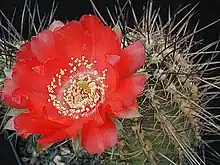Echinopsis haematantha
Echinopsis haematantha, is a species of Echinopsis found in Argentina and Bolivia.[2][3]
| Echinopsis haematantha | |
|---|---|
 | |
| Scientific classification | |
| Kingdom: | Plantae |
| Clade: | Tracheophytes |
| Clade: | Angiosperms |
| Clade: | Eudicots |
| Order: | Caryophyllales |
| Family: | Cactaceae |
| Subfamily: | Cactoideae |
| Genus: | Echinopsis |
| Species: | E. haematantha |
| Binomial name | |
| Echinopsis haematantha (Speg.) D.R. Hunt | |
| Synonyms | |
|
List
| |
Description
Echinopsis haematantha grows singly or branching, and then forms small groups, with a large carrot-like taproot. The flattened spherical to short cylindrical, olive green to brownish green to gray-green shoots reach heights of up to 12 centimeters with diameters of 5 to 8 centimeters. There are twelve to 15 low and narrow ribs arranged in a spiral. The circular areoles on them are white. Yellow to dark brown or black thorns emerge from them. The one to four unequal, strong central spines are often hooked and up to 6 centimeters long. The ten to twelve thin, needle-like marginal spines are interwoven. They are up to 1.2 centimeters long.
The short, funnel-shaped, yellow to orange to slightly purple flowers open during the day. They have a diameter of 3 to 4 centimeters. The spherical to egg-shaped, green to purple-brown fruits are semi-dry and tear open.[4]
Distribution
Echinopsis haematantha is widespread in the Argentine provinces of Salta, Tucumán and Catamarca at altitudes of 2000 to 3000 meters.
Taxonomy
The first description as Echinocactus haematanthus by Carlos Luis Spegazzini was published in 1905.[5] The specific epithet haematantha is derived from the Greek words haima for 'blood' and anthos for 'flower' and refers to the dark red flowers of the species. David Richard Hunt placed the species in the genus Echinopsis in 1991. Another nomenclature synonym is Lobivia haematantha (Speg.) Britton & Rose (1922).[6]
References
- "The IUCN Red List of Threatened Species". IUCN Red List of Threatened Species. 2010-09-22. Retrieved 2023-10-08.
- "Echinopsis haematantha". Tropicos. Retrieved 2019-08-22.
- "Echinopsis haematantha (Speg.) D.R.Hunt — Plants of the World Online". Plants of the World Online. Retrieved 2023-10-08.
- Anderson, Edward F.; Eggli, Urs (2005). Das grosse Kakteen-Lexikon (in German). Stuttgart (Hohenheim): Ulmer. p. 230–231. ISBN 3-8001-4573-1.
- Aires., Museo Nacional de Buenos (1905). "Anales del Museo Nacional de Buenos Aires". Impr. de Juan A. Alsina. Retrieved 2023-10-08.
- "Notes on miscellaneous genera of Cactaceae". Bradleya. British Cactus and Succulent Society. 9 (9): 81–92. 1991. doi:10.25223/brad.n9.1991.a2. ISSN 0265-086X.
External links
 Media related to Echinopsis haematantha at Wikimedia Commons
Media related to Echinopsis haematantha at Wikimedia Commons Data related to Echinopsis haematantha at Wikispecies
Data related to Echinopsis haematantha at Wikispecies


.jpg.webp)